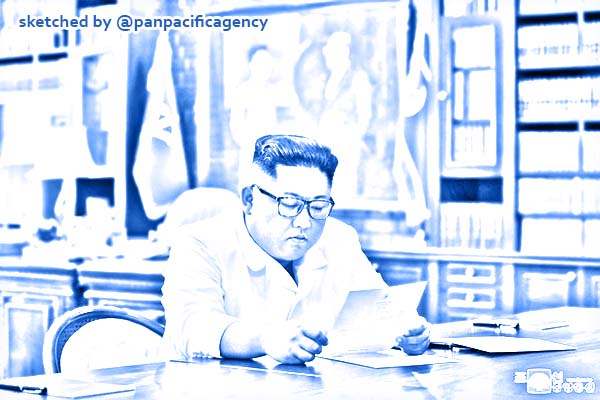[Analytics] The resumption of Trump and Kim’s correspondence diplomacy

North Korean leader Kim Jong-un reads a personal letter from US President Donald Trump. (KCNA/Yonhap News). Sketched by the Pan Pacific Agency.
“Correspondence diplomacy” has resumed between North Korean leader Kim Jong-un and US President Donald Trump. After floundering in the wake of the failed North Korea-US summit in Hanoi on Feb. 27–28, the Korean Peninsula peace process is once again returning securely to a track of dialogue and negotiations. Lee Je-hun specially for the Hankyoreh.
Analysts are predicting momentum for dialogue and negotiations regarding the Korean Peninsula peace process will emerge from talks among the heads of state of South and North Korea, the US, China, Japan, and Russia in the wake of the North Korea-China summit on June 20–21 in Pyongyang, the G20 Summit on June 28–29 in Osaka, and a South Korea-US summit on June 29–30 in Seoul.
What remains is the complicated question of how to bridge the broad and deep division between Pyongyang and Washington that has formed from the “trauma” of Hanoi and come up with substance to include in the dialogue and negotiations. It will be a difficult process, the success of which is by no means assured. At the same time, it is also clear that the Korean Peninsula “peace clock” has begun moving ahead quickly.
On June 23, North Korea’s three major media – the Rodong Sinmun newspaper, Korean Central News Agency (KCNA), and Korean Central Television (KCTV) – reported that Trump had sent a personal letter to Kim. In a front-page story, the Rodong Sinmun wrote that Kim had “expressed satisfaction” upon reading the letter and called its content “excellent.” Kim was also quoted as “appreciating the political judgment and extraordinary courage of President Trump” and saying he would “seriously contemplate the [letter’s] interesting content.”
The phrase “seriously contemplate” suggests a key to predicting Kim’s future actions with regard to Trump’s letter. A former senior South Korean official and veteran North Korea observer said, “In North Korean parlance, it means he will agree to it.”
The Rodong Sinmun and other media did not mention the timing of the letter’s delivery. Speaking at the White House on June 11 and in a Time interview on June 17, Trump said he had received a letter from Kim the day before. On those occasions, he referred to the letter as “beautiful” and “very nice” (on June 11) and “quite good” (on June 17).
Speaking in a June 13 press conference after a summit with the Prime Minister of Norway, Moon said Kim’s letter “includes some interesting things that President Trump did not share.” His reaction is drawing notice, both as signaling his positive stance toward the letters exchanged between Kim and Trump around the first anniversary of the June 12 Singapore Joint Statement and as indicating that both sides included “interesting” content. This alludes to the possibility that an important message of some kind was shared between Kim and Trump. Regarding the resumption of correspondence diplomacy between the two leaders, a senior South Korean government official called it “evidence that both North Korea and the US see this as a time for [resuming] negotiations.”
Also in need of interpretation is the method and timing through which Kim announced the receipt of Trump’s letter. Noting that the domestic news outlets Rodong Sinmun and KCTV were used in addition to the overseas-oriented KCNA, analysts saw Kim sending his officials and the North Korean public the message that it was “time to move again.” Regarding the timing shortly after the North Korea-China summit, a former senior South Korean official said Kim “seems to have been making a point of saying that his meeting with [Chinese] President Xi Jinping was based on higher-level dialogue and trust-building with President Trump.”
Importance of discussions set to take place during Osaka G20 summit
Now the time has come for the different leaders – US-China, South Korea-China, and South Korea-US – to follow the main channels of dialogue and negotiation with the results that Xi shares in Osaka from his discussions with Kim, based on the “shared perspectives and common understanding” referred to between the North Korean and Chinese leaders in the June 21 and 22 editions of the Rodong Sinmun. Another question is whether behind-the-scenes communication takes place at Panmunjom when Stephen Biegun, the US State Department special representative for North Korea, visits South Korea early next week.
Trump has continued to insist on the importance of maintaining sanctions, while Kim openly called on the US to develop a “methodology that can be shared with us” and a “new calculation” during a Supreme People’s Assembly policy speech on Apr. 12. In the wake of the Hanoi trauma, neither side has been able to fully shake the fear of failure.
“Working-level talks are unavoidable if another failure is to be avoided, and it looks like there’s going to be a bit more high-level wrangling ahead of that for exploring options and setting the stage,” said a senior-level source acquainted with the situation.
Another former senior official said, “In the end, ensuring the dialogue’s substance will require an approach such as having a senior US official go to Pyongyang or Kim Jong-un sending a special envoy to the US, and it’s tough to tell when that’s going to happen.” Both predictions suggest a lot of ground remains to be traveled.
Moreover, the key driving force that has gotten the Korean Peninsula peace clock ticking once again after its stoppage in the wake of the Hanoi summit has been the battle of tensions among the North Korean, US, and Chinese leaders. Unlike last year, Moon has not been a central figure on the stage – or at least not yet. That explains why many in and around the administration are loudly calling for efforts to increase cooperation with China and achieve progress with inter-Korean relations.